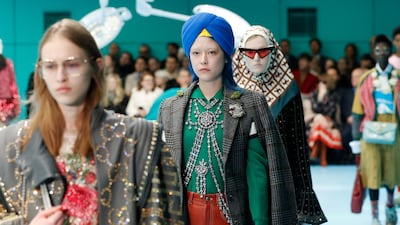Images of a new Louis Vuitton logo-emblazoned keffiyeh stole went viral last week, with Instagram users across the globe quick to point out the scarf's culturally rooted symbolism of Palestinian resistance.
“‘Stole’ is appropriate. Read the room LV. Tone deaf,” commented Dubai fashion influencer Dina Zahran on an image posted by popular fashion watchdog social media account Diet Prada.
The timing, considering the situation in Palestine, is both uncanny and unfortunate, but this certainly isn’t the first time a western brand has come under fire for “copying” a minority culture’s aesthetic.
What is cultural appropriation?
Christian Allaire, author of Power of Style: How Fashion and Beauty are Being Used to Reclaim Cultures, defines it in his book: "Cultural appropriation is when members of one culture adopt elements of another culture without their consent. This happens often in the fashion world: indigenous design motifs have been long copied or replicated by non-indigenous fashion brands, who often misuse traditional elements or ignore a piece's original purpose."
Allaire, who hails from Canada's First Nations Ojibwe tribe, tells The National why cultural appropriation is so dismissive and discriminatory to indigenous communities. "I always feel angered when I see a non-indigenous brand appropriate our culture.
"There are so many authentic artists out there who are thoughtfully carrying on their traditions, and it is so disheartening to see mainstream brands come in and just copy their work,” he says.
“For years, our people were told that our cultural practices were savage or not beautiful, and it is now ironic that so many brands want to replicate what we are creating. It undermines their hard work and knowledge when they take from them and make a cheaper version.”
An age-old controversy
In May, Mexico's Ministry of Culture accused Zara and Anthropologie of using "the collective property" of indigenous Mexican communities, shortly after it blasted Isabel Marant for also exploiting Mexican motifs.
Hermes has sold silk scarves depicting a Native American chief, Tory Burch has designed a sweatshirt suspiciously similar to Portuguese Baja designs – the list goes on.
“Cultural appropriation has been a mainstay in the fashion industry for decades,” says Reina Lewis, professor of cultural studies at the London College of Fashion.
“For too long I think parts of the fashion industry have treated the term ‘inspiration’ as an alibi. But, there’s increasing public and consumer awareness that it’s not simply OK to take inspiration from fashion and textile traditions without some recognition of or recompense to the communities from which those aesthetics derive.”
Monique Spearman, a stylist and curator of the Instagram account @blackowneduae, who is based in Dubai, says many big brands have appropriated black culture – from Marc Jacobs’s spring 2017 runway show that featured models with dreadlocks to Gucci’s notorious “blackface” balaclava jumper.
She also mentions the 2016 Valentino collection that was a clear tribute to Africa, yet predominantly featured white models, without black representatives.
“This attitude of stealing marginalised groups' culture for profit dates back to colonialism,” says Spearman. “To use culture as inspiration is OK when done tastefully and respectfully, but leaving that culture and people out of the equation and using it for your gain and profit is appropriation.”
South Asian and Middle Eastern aesthetics have also born the brunt of cultural appropriation in fashion, including the traditional “ajrak” pattern originating in Sindh, Pakistan, which has been used by brands such as Forever 21 and Urban Outfitters without mention of its roots.
“When I was studying fashion I used to see how others used other cultures as part of their projects without giving credit where it’s due,” says Tabbasum Qureshi, an international consultant who previously worked in the fashion industry. “When a plainly obvious shalwar kameez is renamed ‘tunic costume’, this becomes highly problematic.”
In April, Asos launched South Asian wedding attire, which sparked controversy, even though they were conceptualised by an Indian designer, labelled as lehengas and photographed on a brown model.
Twitter users claiming this to be cultural appropriation stated that the sequins and embellishments used to adorn the garments were cheap, fast-fashion attempts to replicate the intricate beadwork and painstaking craftsmanship used in authentic South Asian designs.
Then there’s the keffiyeh scarf, which has been a contentious point of cultural appropriation among Arab communities pre-dating Louis Vuitton’s rendition.
Gucci, Chanel and even Topshop have all used the quintessential Palestinian scarf pattern in their designs.

Danish label Cecilie Copenhagen has been using it for her popular handloom garments for about a decade, never crediting the source of the inspiration, until last year when thousands of social media users protested through comments on the brand’s Instagram page, citing phrases like “cultural theft”.
Pinpointing power dynamics
“Fashion designers and brands have long drawn on world cultures, religions and communities for aesthetic and textile ideas, as have European designers drawn on intra-European textile heritages – but that doesn’t tend to get talked about as ‘cultural appropriation’ and that’s often to do with power differentials,” explains Lewis.
“It opens up a much wider conversation which is really about integrity – thinking about power dynamics, thinking about histories and thinking about contexts."
These are issues that the next generation of fashion designers is growing increasingly aware of.
“Our students and colleagues are highly concerned with questions of cultural appropriation, and it sits alongside moves to decolonise the curriculum and to widen the frame of fashion education so that it de-centres western fashion as a definitive form of fashion, and includes world fashion cultures and histories,” says Lewis.
Double standards about appearances are also highlighted with cultural appropriation – only when ethnic fashion receives a “western” stamp of approval, is it deemed trendy.
“When the mainstream industry amplifies something as fashion it gets taken out of its denigrated realm of ethnic fashion and becomes fashionable,” says Lewis. “It gets sacralised as fashion when it’s worn on non-brown bodies.”
Calling out cultural appropriation
While cultural appropriation may be an unfortunate reality of the art and fashion industries, consumers are becoming increasingly aware of it, largely thanks to social media campaigns that blast brands for unethically portraying marginalised cultures.
Allaire believes that the only way cultural appropriation will ever end is if consumers keep calling it out. “We must not only criticise those who do it, but educate them about why it's wrong, too,” he says. “There is power in changing minds, even if it is only one small step at a time. It's the only way forward.”
Spearman says consumers have a responsibility to shop ethically and raise awareness about injustices in the fashion industry.
“Consumers must refuse to spend money on brands that continue to miss the mark. Using social media to demand change from brands has helped to bring more awareness but we aren’t finished doing the work,” she says.
Consumers clearly play a critical role in this movement, and opinions vary over whether cultural appropriation is incited when they independently purchase and wear clothing from marginalised communities. Lewis says that the subject remains complex, with contested definitions of ownership: “In the Emirates you have an amazing abaya fashion design industry, so if somebody not Emirati or not Muslim comes over and is wowed by these beautiful products, is it cultural appropriation if they buy one and wear one?”
According to Allaire, ethnically rooted aesthetics are not wholly off-limits for brands and buyers. He encourages cultural “appreciation” over “appropriation”, which consists of buying pieces from authentic artists straight from the sources, and of brands collaborating with artists from these communities – involving them in the design process, instead of touting the craftsmanship as their own.
Deeper questions about diversity
Moving forward, mere apologies from brands culpable of cultural appropriation, says Spearman, will not suffice.
“Apologies are really ‘cute’ and great for short-term press, but it’s the changed behaviour that makes the difference. Cultural appropriation is a huge red flag that the brand has minimal diversity or representation behind the scenes,” she explains.
“This isn’t going to be the last time a story like this emerges about cultural appropriation, and what it emphasises is how much we need more diversity, in all components of the fashion industry," says Lewis. "Fashion brands and houses really need to look to their own, and improve their diversity.”



